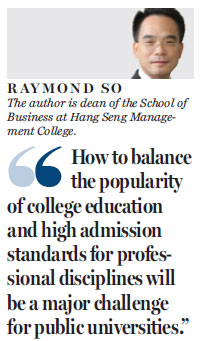Lower fertility rate poses challenges for universities
Updated: 2016-03-31 08:41
By Raymond so(HK Edition)
|
|||||||||
According to the documents submitted by the Education Bureau to the Legislative Council, there will be around 57,000 candidates sitting for the Hong Kong Diploma of Secondary Education Examination (HKDSE) this year. It is estimated that around 22,000 candidates can score minimum standards to enter government-funded universities. Together with first-year undergraduate places supplied by self-financed post-secondary institutions, the available number of first year undergraduate places will total 24,000. Simple arithmetic tells us that the number of first year undergraduate places exceeds the number of appropriately qualified students. In other words, all of those who meet the minimum university entrance requirements can secure a place. Of course, this phenomenon of over-supply is really about the total number of places. If we only look at the number of government-funded places, we can see that competition is still keen. It is not surprising to hear suggestions that the government should increase the number of government-funded undergraduate places.
Numbers are objective evidence. Nowadays we can have a 100 percent participation rate in university education for those who are eligible. This trend has not gone unnoticed. Earlier we had seen cases where some primary and secondary schools were forced to close down due to insufficient levels of enrolment. This trend can be traced to a declining fertility rate which has in turn led to a decline in the number of students. The phenomenon of oversupply in undergraduate places is a natural consequence of a lower fertility rate. This can be a threat, as well as an opportunity, for Hong Kong. We need to be careful how we deal with this situation.
For students taking the HKDSE this year, the oversupply of undergraduate places is welcome news. In the past the number of qualified students far exceeded the supply of university places. As a result, many qualified students could not enter universities. Now with a lower fertility rate, students have a greater chance to enter universities; they will also face less pressure during their studies.
However, this will also pose a major challenge for universities. When university education becomes more accessible to young people, universities face a big problem balancing the quality of education with its popularity. Currently, only about 18 percent of young people in Hong Kong can receive a university education. Because of these limits, competition for university places is very fierce. With the decrease in the number of candidates, competition for university entrance will be more moderate. This suggests that the requirements for admission could be lowered. This problem will be particularly acute six years later because, according to projections by the Education Bureau, the number of young people sitting for the HKDSE will hit a record low by then. According to the government's estimates, the number of students qualified for university education will decline further to 17,000 in 2022. With some students going abroad to study, the number of qualified candidates entering local universities will be equal to the number of government-funded places. In simple words, every qualified student can secure a government-funded university place.
Currently, some professional disciplines have high admission standards. With the decline in the number of qualified candidates, these professional disciplines will face a decline in overall student quality. This will inevitably have a negative impact on the quality of their graduates. University education should not be vocationally oriented. But in the traditional university system in Hong Kong, a number of professional disciplines - such as medicine, engineering and law - are taught at undergraduate level. When the overall quality of students admitted is lowered, it will have a major impact on professional education. How to balance the popularity of college education and high admission standards for professional disciplines will be a major challenge for public universities.
Moreover, the task of a university is to educate people. When the total number of local children falls, universities need to look for candidates from other sources to fill the gap. From the experiences of neighboring cities, the natural way to combat the problem of insufficient students is to have more international students. But this will lead to other concerns like the language of instruction, competition for dormitory places, resource allocation, and so on. It can be said that the admission pressure is a Pandora's box. We should handle all the problems with a holistic approach. From society's viewpoint, the decline in Hong Kong's birth rate, making university education more accessible to young people, is not necessarily a bad thing. One thing we need to bear in mind is that quantity does not imply quality. We need to maintain quality of education under the higher participation rate of university education. With only six years to go, we simply do not have the luxury of postponing further action.

(HK Edition 03/31/2016 page10)